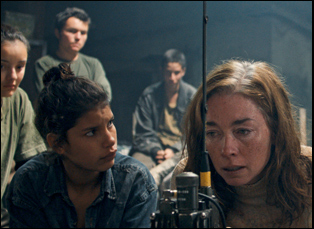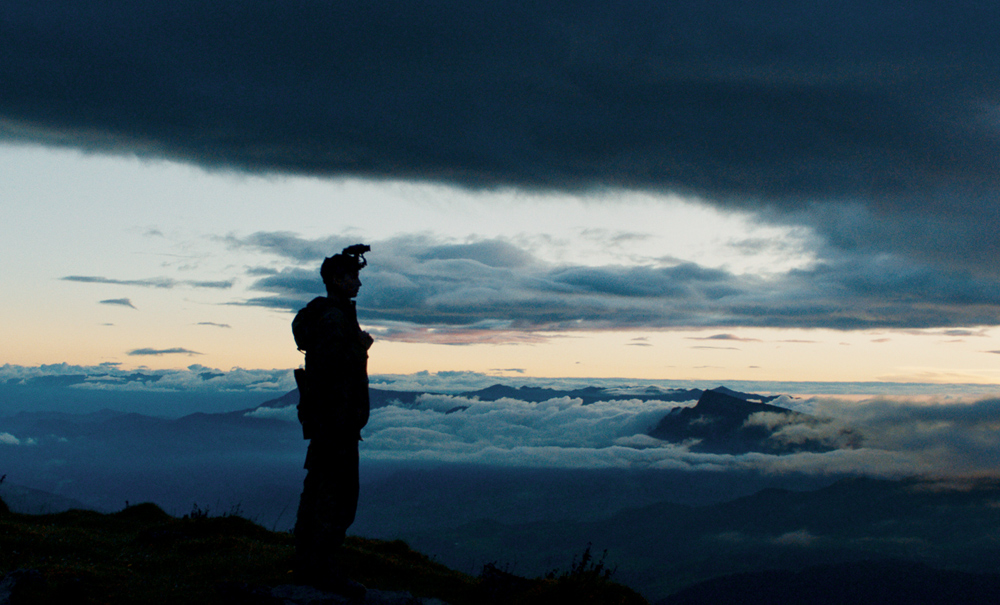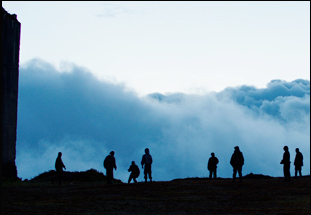On the mountain top where “Monos” begins, it’s difficult to tell where earth ends and the heavens begin with the summit so high it’s tucked into the clouds. A group of kids from mere toys to teens clown around with abandon, awaiting word from a messenger about what they should be doing, as guns set off to the side suggest they’ve lost their innocence long ago, but their actions prove otherwise, playfully roughhousing and testing each other out in any number of ways to see what the limits are. As director Alejandro Landes gradually reveals in his staggering second narrative feature, these are child soldiers tasked with keeping an eye on an American doctor (Julianne Nicholson) taken as a hostage by the commandos fighting in other parts and just as they have to feel things out for themselves in an area with no clear boundaries, they have to develop a moral compass without any guidance as well.
While the kids are in unknown territory, Landes makes sure that audiences feel the same way in crafting a gripping thriller, filming in parts of South America that are rarely touched by man and employing an ethereal score from “Jackie” composer Mica Levi to accentuate the feeling of a place that’s removed itself from time, as the kids are stuck in arrested development and the doctor has lost touch with the world and wonders if she’ll ever return. Although clearly influenced by “Lord of the Flies,” “Monos” has no peer as a sensory immersion and as all kinds of questions of identity are raised for the kids, Landes pushes you to lose yourself in the film completely. Following its premiere at Sundance earlier this year where Landes picked up a World Cinema Special Jury Award, this unique cinematic experience is coming to a theater near you and recently the director spoke about the influences behind it and how on earth he survived making it.
The political situation in Colombia did inspire me and I have a grandfather who fought in World War II, landed in Normandy – I heard stories from him, so the idea of making a war film [was interesting], but also a mirror to that time in your life that I think we’ve all shared that’s a very peculiar, very conflicted moment, which is that borderline moment between childhood and adulthood. Mirroring those two conflicts was something that seemed appealing to me, and of course, when I was thinking about the genre, I had seen beautiful films like the Russian film “Come and See” and Claire Denis’ “Beau Travail” and “Apocalypse Now” and then things that I read when I was the age of the protagonist, like “Heart of Darkness” by [Joseph] Conrad or “Lord of the Flies” [where] for the most part, war provides a sort of window into human nature, something that would come out regardless of war, but war provides a certain catalyst, so that was what the setting was.
You do capture this innocent time for these kids, even as they’re carrying weapons and obviously thrust into a very adult world. Was that difficult to hold onto?
What we were trying to do was we were trying to steal from all these different places – yes, the Colombian civil war, but we also looked at the rebel Rastafari movement of the ‘60s and ‘70s, we looked at the uniforms the Russian army wore to go to Crimea, and we looked at what’s happening in Syria. We looked at all these different conflicts to create our own in terms of images, but we wanted to make sure that we brought you into the trenches. When you’re down there with the lowest rung of the military in terms of the hierarchy, they’re not there discussing ideology. You’re there in the blood, sweat and tears of this trench and that’s what I wanted to create. And an atemporal [setting] as well. Very purposefully, the film looks like it’s post-apocalyptic. Sometimes it looks like the ‘60s and ‘70s. This doesn’t necessarily have a time or a name of a place because people feel really comfortable when they get a first name, a last name, a date, a place, and the film doesn’t give you any of that.
Did you have a strong idea of how you’d use music from the start? I was surprised to learn after it’s only about twenty minutes’ worth when it feels like such a presence.
It was key that the music played with the atemporal element. There’s a minimal monumentalism that the film has also because the premise and the containment of just a squad with one mission, to give you this kind of epic journey. Mica accomplished that with something as simple as blowing in a bottle — that creates a very strong whistle and then [we could] juxtapose with the more synthetic sounds that come out of a synthesizer. We also were giving musical notes to certain characters, like the messenger when he appears on screen, he has a very shrill whistle that allows you lord over the kids. [That was] something out of the pages of ”Peter and the Wolf” [where] there’s that whole symphony and each character has a musical instrument.
Obviously, you assemble such an interesting cast as well. Is it true you set up a boot camp that you ultimately picked your kids from?
The foundation of “Monos” was that time we spent together before starting to shoot, about five weeks or so where we have initially about 25 kids from the 800 we’d seen initially and then we narrowed that down to eight. There was no traditional casting process. We were just looking at kids when we were walking down the street, going to schools, going to acting workshops. I had a bunch of people looking all the time. Sometimes we were looking at videos, sometimes we invited to workshop in some town, and it was key to see them interact between each other and see the chemistry between them to be able to choose the ensemble and I rewrote the screenplay with Alexis Dos Santos during that period to make sure we were bringing what we knew of the kids onto the page – who flirted with who, who fought with who, that type of thing.

I was still looking for that role when he was my consultant, but in the end, he was so good, the juxtaposition between the authority that he has and his size created that fable-like quality you were mentioning. And he was a little scared at first [of taking on the role]. This is a guy who was a child soldier since he was 11. He deserted when he was 24 and he was slowly coming back to civil society — not coming back, actually, but almost like entering it for the first time. It was amazing to have him with us. He’s very smart and he knows so much and he was like, I can’t believe I can use all these forces of destruction that I’ve learned to create art.
Since you started out in documentary filmmaking, do you find you can draw on that experience to make narrative films?
What documentary helps you do is it helps you withstand the not knowing because you don’t really know what’s going to happen, so instead of you expecting all the time to project your ideas on what you’re filming. You learn to look. That’s what helped me when I made my first fiction feature “Porfirio” that premiered in Cannes in 2011, and that juxtaposition between the naturalism of the places and the faces versus the stylization of the mise-en-scene is something that I worked on with “Porfirio” and now on “Monos” where I think that creates an interesting discomfort for the viewer. But I try not to go at things with classification like “this is this” or “this is that.” I try to build something that’s fresh and new.
I get that feeling since “Porfirio” and “Monos” are very different films.
They’re much more similar that it would look at first glance. There’s a very strong identity in “Porfirio” and in “Monos,” and that’s what I’m working on, making sure that the film has a unique fingerprint. In the case of “Porfirio,” there’s something very strong, but there’s a containment that comes from a man in his fifties in a wheelchair and the prison of the soul in the body whereas here, you don’t have one protagonist, but ten and they have their life ahead of them, so one film is about movement and the other film is about containment in a way.
Was the opening scene of “Monos” on that mountaintop what you actually shot first?
Yeah, it was. We respected a certain chronology. Not always, but we respected it some. I remember somebody was hauled off in an ambulance the first day of shooting because we were nearly 14,000 feet in the air – we were really high up there. And I thought that would be the toughest day, but in the end, that was just the beginning. Every day was a beast. This film took everyone to the limits.
You can tell, but the end results are spectacular. I couldn’t help but ask about one scene that takes place in an idyllic cove where Doctora, played by Julianne Nicholson, swims in this beautiful blue water and yet she’s tethered by a chain to the cliff as a prisoner. That seemed so fitting for the position that everyone is in during this movie, did that imagine come to mind immediately?
Yeah, it was a very strong image and it works with everything that happens in the film because the lines between paradise and hell are very thin. I actually read some biographies of people that had been kidnapped in Colombia and they write about how they were in the most beautiful place they had ever seen, straight out of their biblical paradise, and it was their hell because they were there by force and kidnapped. That touched me, so I thought that juxtaposition between the water, swimming, the light and then the chain was very strong.

Yeah, especially in live locations. None of this is shot in a tank and Peter has a lot of experience and he was with us for about three or four days. He has some special housing equipment, so it was great to have him to be able to do scenes that were so technically hard to pull off.
And it’s really exciting because the structure [of the film] — something that was in my head was this idea about following the river and to have people now come out of the film and really feel like they were thrown into that river experience, to go on that journey has been very exciting because the film begins at the reservoir of water for the nation, Páramo, a very special endemic wetland that exists at that [high] level and then the water comes down the mountain gaining more and more speed until it ends up in torrents at the bottom of the lowlands. That was a very cerebral thing, but now people live it in the flesh and the skin and I’m kind of very excited that many times we regard films with our head and people are really living this film in their stomach. I like that.
“Monos” opens in limited release on September 13th, including in Los Angeles at the Landmark and New York at the Landmark at 57 West.





